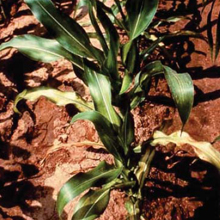
Zinc deficiency in corn. For more photos of nutrient deficiency in a wide range of crops, click here.
Zinc (Zn) has been put to work on farms for decades. Fencing wire and nails are galvanized with zinc to prevent rust. Metal buckets are coated with Zn to last longer. However, Zn’s most important job is in the field, as one of the 16 essential elements in plant growth.
Zinc deficiency is growing in the Midwest, and it’s more likely to occur in corn than soybean fields. This is due in part to earlier planting of corn in cool and moist soil. Also, more residue resulting from conservation tillage and higher grain yields places added stress on seedlings to absorb Zn from soil.
Zinc is heavily involved in enzyme systems that regulate the early growth stages, and is vital for fruit, seed and root system development; photosynthesis; formation of plant growth regulators; and crop stress protection. In addition, Zn is a team player with nitrogen (N), phosphorus (P) and potassium (K).
However, soils require Zn in very small amounts compared with N or K. Only about a half-pound of Zn is needed per acre for high-yield (180 bushels per acre) corn production. Sixty-bushel wheat needs about 0.28 pound of Zn per acre. Yet, lack of Zn can limit plant growth, just like N or K, if the soil is deficient or crop uptake is restricted.
Give plants a good start
Crops need readily available Zn, especially when plants are young and growing vigorously. Zn does not move in the soil, so the small seedling’s root system may have difficulty finding and taking up Zn reserves. Zinc availability and uptake also can be limited by other environmental and crop management practices, including:
· Liming to reduce soil acidity. Availability of Zn to plants declines as soil pH increases. Zinc is usually more available as soil pH moves to the acid side of 7. Be alert for a Zn shortage for sensitive crops growing on soils with pH 6 or higher.
· Low soil temperature. Soil temperature affects the solubility or availability of Zn in soil, and solubility decreases as soil temperature drops.
· Reduced-tillage systems. Crop residues on the soil surface at planting time shade the soil, resulting in a lower soil temperature and higher soil moisture level. These conditions put stress on a small root system, making it difficult to uptake required Zn, as well as P and Mg.
· Low organic matter. Zinc availability also has been linked to soil organic matter content. The soil test for Zn usually increases as the soil organic matter content increases. So, Zn deficiency symptoms will usually appear first on eroded portions of the landscape where the organic matter content is low.
· Early crop-planting windows.Growers now seed corn and certain vegetables earlier in the spring, when soils are cool and moist. This compounds the stress on seedlings caused by reduced tillage and makes a readily available supply of Zn and other nutrients even more important to ensure early plant growth.
· Soils testing low in Zn and high in P . Soil-test each field to help identify where crops will respond to Zn. Fields that test low in Zn and high in soil pH and P need attention first.
University scientists report that a low Zn level, teamed with a high soil pH, can increase crop uptake of P to an excessive level. A shortage of Zn severely impairs the plant’s ability to regulate P accumulation. This triggers excess uptake of P and the development of Zn deficiency symptoms.
Getting ready for next year’s crops starts now
Soil and plant analysis labs provide guidelines for sampling fields, evaluating crop need for Zn and determining the amount of fertilizer Zn needed to correct a deficiency.
Soil-sample fields carefully and analyze the lab reports on a field-by-field, crop-by-crop basis with your agronomic adviser. Remember, a Zn deficiency is often not visible at the high-yield level. That makes soil and plant analysis key detection tools.
Knowing the multiple conditions that create resistance to root uptake of Zn will help to determine when Zn should become a member of the balanced nutrient team.